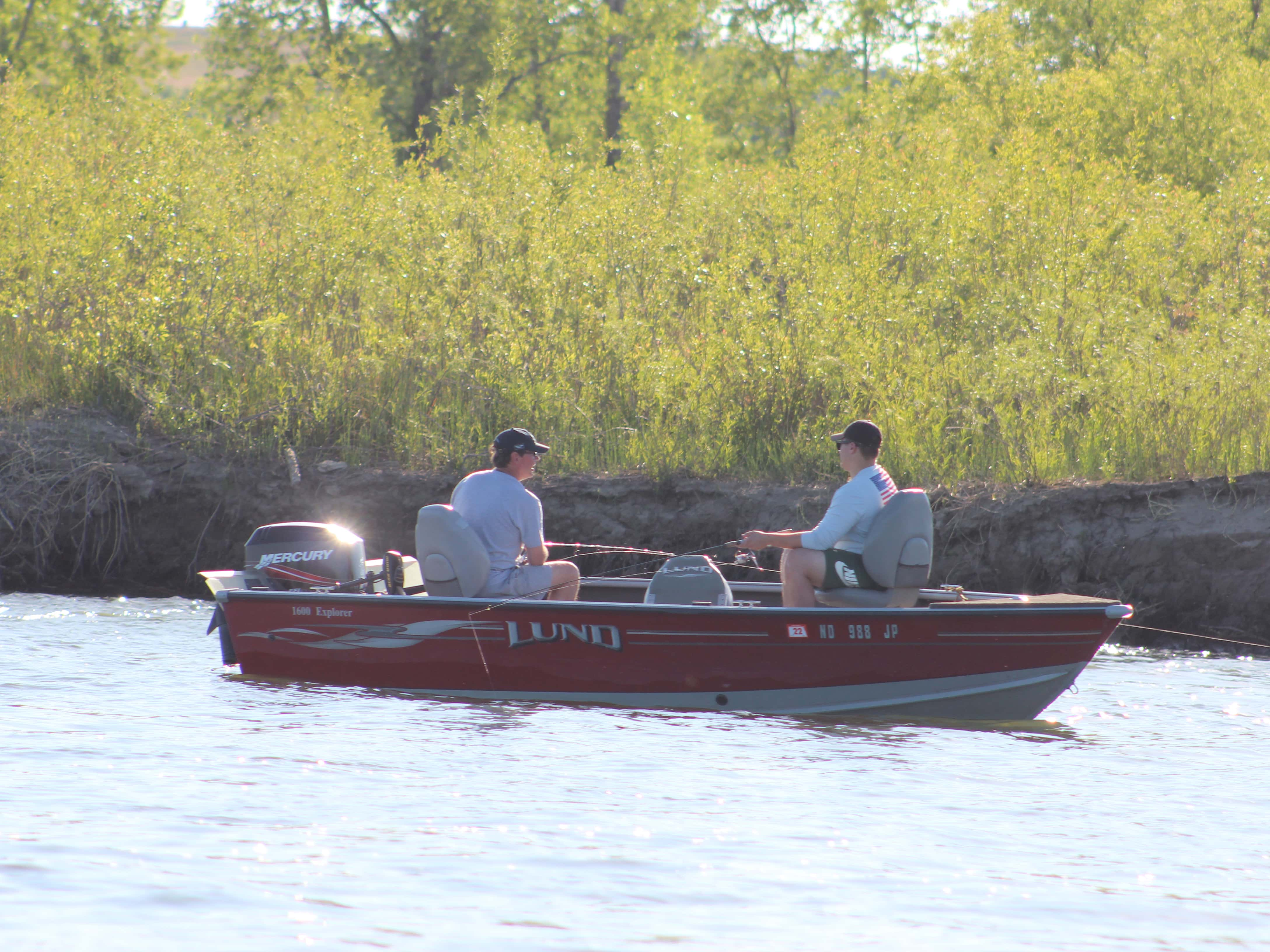
A pair of anglers work the deeper edge of the main river channel in search of walleyes on a warm and sunny day. Look for fish a bit deeper when waters warm and the sun is at its peak. Simonson Photo.
By Nick Simonson
Growing up in the upper Midwest taught me to relish the warmth of summer. Sometimes those stretches of 90-degree days spanned just a week or two in August. Other summers, the warmth seemed to highlight the entire 12 weeks we were out of school.
In between backyard kickball games, neighborhood-wide all-day water gun fights and kick the can contests at dark, were canoe treks up the river and fishing for bullheads from its banks. As angling became more of the focus in my life, we’d seek out the shade under the trees upriver casting after smallies and white bass, or dodging the sun’s direct light by waiting for an evening of trolling for walleyes on nearby lakes.
The glory of hot summer days, however, isn’t for everyone and certainly isn’t for fish that have no way of blinking out the bright sunlight, or those that get stressed by warming waters. That is why knowing where fish go when things get bright and hot is key in keeping them on the line all season long. By exploring cover, working deeper water, timing things right and finding areas where things are just a bit cooler, the odds of hooking up with fast summer action are increased. What follows are some general rules to consider as temperatures rise and fish adjust to the warmth of the season.
Casting Shade
A quick way for fish to get out of the bright sunlight is utilizing structure that casts a shadow on the water. Whether that’s an overhanging elm tree, or the arch of a road bridge crossing the water, these places are must-check locations for fish as summer settles in. The darkness allows them to rest their eyes, and target prey that happen to move through the area, which may not be as visually strong as say largemouth bass, crappies and walleyes are. Work the edge of any such shadow and get closer to the middle to find where fish are holding. Don’t rule out underwater structures providing a break from the sunlight either, as submerged trees can cast shadows and provide holding places for fish, along with the basics of the food chain that attract minnows, crayfish and other prey items.
Deep Thoughts
Though by no means a chemist, I can tell you that deeper water is generally cooler water and when the upper stretches of the water column warm, the lower regions typically aren’t as hot. This is where many species go to beat the heat, and summer patterns set up a few feet deeper than they were just a couple of weeks ago. Shift trolling efforts and jigging presentations for walleyes out a few feet from where they were previously to connect with fish as they adjust to the warming shallows and seek cooler environs. For those gin clear lakes, it isn’t unusual to find bass pushing out deeper to avoid the strong sunlight at midday, and working tubes, jigs and other heavier offerings around deep structure will help connect with fish.
Dusk Til Dawn
Low light conditions also allow a reprieve from the heat and light of summer for fish and give them a chance to move in shallow at sunset and sunrise to target baitfish and young-of-the-year panfish. Time trips in the early morning or late evening to connect with fish that get more active as the sun’s angle shifts toward evening. From walleyes to crappies to white bass, evenings provide great options as these fish school up and feed. Overcast days will also help keep fish up shallow, especially if those conditions aren’t accompanied by instability and windy days will provide some turbidity that can draw predators shallower when the water gets stirred up along the shoreline where the waves are crashing. Utilize low light periods and those conditions that limit light penetration in the shallows to move in and find where fish are.
Spring Forward
Finally, locating those areas that provide a natural inflow of cool water can also aid in finding active summer fish. Whether it’s a small seep along a trout stream, or an inflowing spring fed creek that brings cooler water into a lake or larger river, these places are worth a note on the map or a mark on the GPS, as fish will likely congregate nearby and forage in the inflowing water when things get hot on the main flow. With the help of a thermometer or taking note of the temperature readout on a depth finder, it’s easy to compare the conditions in the cooler stretch with those around it, and start putting the puzzle together from there.
By finding the ways that fish beat the heat, it’s likely that angling efforts will improve throughout the summer. Focus on the factors fish need to stay comfortable, such as shade, cover and cooler temperatures and those natural and man-made features that provide them to connect with great summer fishing…in our outdoors.
